Day 8 – December 3, 2015 - Part II
At 7 PM we left the chalet by car to get to the meeting point for the night drive, which this time would be with Charl, with whom we did a night drive and the Cheetah-tracking during our visit in 2014. The first other passenger was the female birder with the Jacobin Cuckoo we had met earlier that day and it turned out that she was originally from Germany and had moved to East London several years ago. We exchanged information about where we had seen what bird species and as we got into the vehicle she sat down in the front row with us.
In addition to the three of us in front, there was a German speaking couple in the middle row and a South-African couple (who were now living in Australia and staying in one of the mountain huts for which you need a 4x4) in the rear.
It was a warm evening with a southerly wind that seemed to have quieted down for the time being and we set out from the rest camp, turning right onto the main road. Charl immediately picked up a Duiker which skulked into the thicket. There were three Kudu munching on a flowering acacia that had been pushed over early that morning by a rhino. A pair of Ostriches was settling down to sleep and a male Kudu was still browsing in the vegetation.
We turned left onto the Umngeni 4x4 road and shined the torch on a female Steenbok. Our next animal was an Aardwolf that was walking away from us, but Charl soon found us another one that we could see for more than a few seconds. Our first Springhare of the evening didn’t have its characteristically long tail which led to speculation on whether it had been bitten off by a jackal. Another Springhare was standing still on our right and munching on grass, holding its front paws just below its chin, and it didn’t spring off when we stopped to have a look at it. As we drove further, we saw our first Black-backed Jackal, several Red Hartebeest, and three Mountain Zebras.
The first highlight of the drive came in the form of a Bat-eared Fox, which we hadn’t seen on our 2014 trip and which Adam had requested at the beginning of the drive. It was walking alone, back and forth, increasing and decreasing its pace, seemingly looking for its mate (they usually go out in pairs), and at one moment was face to face with a Black-backed Jackal. Both animals decided that they didn’t pose any threat to each other and walked their separate ways. More Springhares, revealed by their hopping reflective eyes, started appearing as we entered the Ubejane Loop and drove on a smoother road for a while.
Near the large, empty dam where we always seem to encounter a male Pin-tailed Whydah, we saw a male Gemsbok, a Springbok, a Porcupine running away from us, and more Springhares. We encountered another Black-backed Jackal and, after a few shortcuts on park 4x4 roads, left the Ubejane Loop at marker 4, but not before encountering a Ground Squirrel that, sadly, had been run over by someone during the day. We saw more Red Hartebeest and some Kudu before the second highlight of the drive.
We saw two Black Rhinos, a mother (the feller of that tree the Kudus had been munching on) and her calf, which we learned was a male and 23 months old. They were gone in a few moments, disappearing into the thicket adjacent to the Wilgerboom River. Charl said that the calf would stay with the mother until she had another calf, and then it would be the end of his sweet life with mommy as she would expel him (at least for the time that the new calf was small and vulnerable) and he would have to establish his own territory.
The rest of the drive was uneventful and before we knew it we were back at the reception parking area. When we got to our chalet, we looked at the stars again and saw part of the Milky Way.
MZNP - A Nine-Night Stay in Cloud Cuckoo Land*
- Puff Addy
- Posts: 648
- Joined: Sun Jan 24, 2016 7:32 pm
- Country: Czech Republic
- Location: Prague, Czech Republic
- Contact:
Re: MZNP - A Nine-Night Stay in Cloud Cuckoo Land
Day 9 – December 4, 2015
The Hewitt’s Red Rock Rabbit was again around the chalet in the morning as was our crooner, the White-browed Sparrow-Weaver. Our departure from the chalet was delayed a bit by another Hewitt’s Red Rock Rabbit (!) with no white in the fur and no scars opposite Chalet 16. Adam got out of the car and photographed it.
Just another Hewitt's Red Rock Rabbit
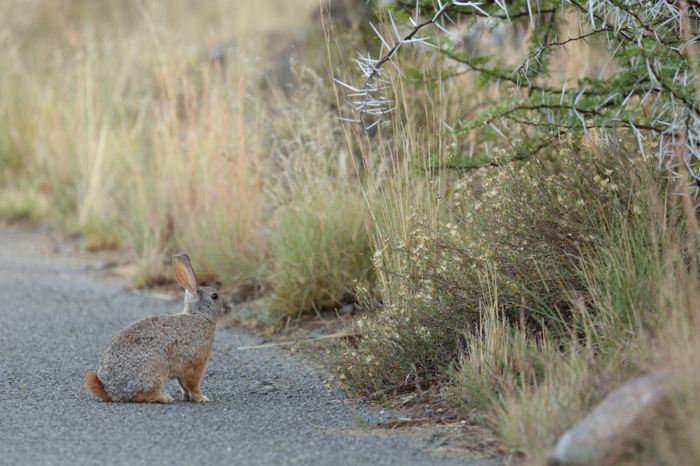
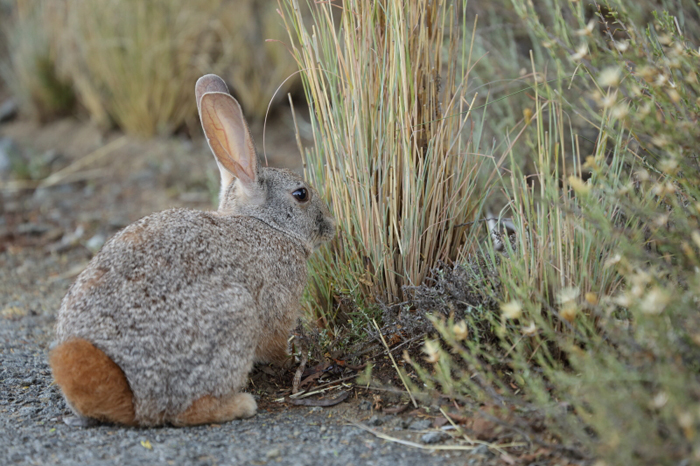
We cleared the gate at 6:08 and turned right onto the main road, seeing two Mountain Zebras and a female Kudu eating straight away and two Yellow-throated Petronias. Our itinerary for this morning’s drive was to start the Ubejane Loop at marker 4, turn left onto the Link Road at marker 3, reach the little dam beyond Graham’s Corner, and then turn around and turn left at marker 3 to complete the Ubejane Loop.
As we crossed the Wilgerboom we heard Hadeda Ibises and later encountered two female Kudu browsing in the acacia tree which had been pushed over by the mother rhino the previous morning. Another female Kudu was spotted up the slope, a Neddicky was heard, and a couple of Ant-eating Chats were in the ‘Springhare’ field.
A Golden-breasted Bunting was singing on a wire in beautiful light and we saw seven Scaly-feathered Finches a bit further on. A Neddicky was spotted in a flowering acacia and a Chinspot Batis was singing nearby. Two female Kudu were browsing through the vegetation to our left as two Greater Striped Swallows flew over heads and a Common Fiscal sat on a wire. Barn Swallows were flying around us as we glimpsed an Acacia Pied Barbet and two White-browed Sparrow-Weavers sitting on neighbouring acacia trees.
We encountered some more Scaly-feathered Finches, heard an African Hoopoe, and saw a Brown-hooded Kingfisher perched on a wire. Five Pied Starlings and a Fork-tailed Drongo were seen with a singing Neddicky and Dideric Cuckoo providing the background sounds. A pair of Grey-headed Sparrows was in a tree and 10 Pied Starlings flew by. We heard another Hadeda Ibis calling and saw it as well. In a bush on the left side of the road, we saw a family of Familiar Chats with one young and another Acacia Pied Barbet.
Scaly-feathered Finch-love

On the right side of the road near the graves of 15 soldiers who had fought in the Anglo-Boer War and had died there, we saw a Sabota Lark, and a bit beyond it there was a Yellow Mongoose.
Between markers 5 and 4, we saw a Common Fiscal, a White-browed Sparrow-Weaver, a pair of Greater Striped Swallows perched and one of them preening, a Chestnut-vented Tit-Babbler, a Neddicky, and a wire-perched Familiar Chat. Then all of a sudden, a Green Wood-Hoopoe flew across the road and landed in a tree! Adam heard an African Rock Pipit from the rocks above on our right. Almost at marker 4, we could add a Fork-tailed Drongo, a pair of Fiscal Flycatchers, a calling Bokmakierie and two female Kudu to our field notes.
As we turned left onto the Ubejane Loop, a Karoo Scrub Robin and a family of at least four Familiar Chats welcomed us. A few Ground Lilies had sprung up after yesterday’s thundershowers. There were Springboks on our left and right (10 and 37, respectively) foraging, wagging their tails and springing into the air. A male Ostrich kept his cool amidst all the activity. Before the first drift we saw a Pied Starling on a power pole with one Common Fiscal and a Fork-tailed Drongo on a wire and a pair of Grey-headed Sparrows apparently nesting under a transformer high up on the pole.
Ground Lily
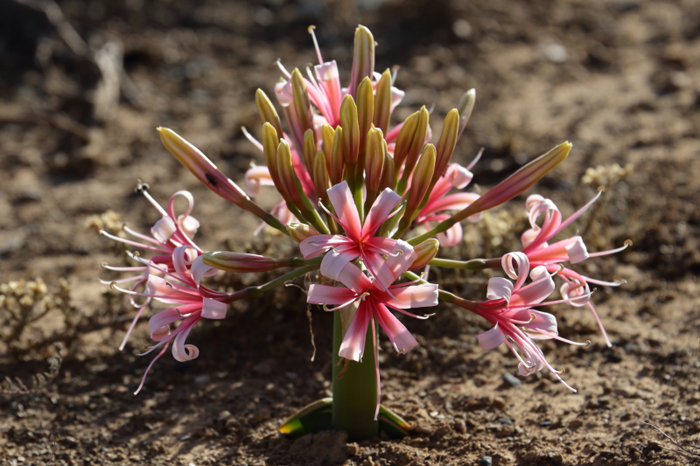
As we entered the Southern Ground Squirrel Area, we saw three pairs of Cape Sparrows, an Ant-eating Chat, a Ground Squirrel in the distance, and a Hadeda Ibis strutting through the field. There were also five Grey-headed Sparrows and several Scaly-feathered Finches, and we heard a Dideric Cuckoo again. Two Yellow Mongooses were having a wrestling match, jumping at and biting each other and rolling around on the ground. African Pipits, Ant-eating Chats and another Ground Squirrel were spotted and then we encountered a lone Red Hartebeest grazing on the left side of the road.
Barn Swallows were flying above us, more Scaly-feathered Finches were busy between the shrubs and trees, and a Cape Turtle-Dove was eating by the roadside. Three Rufous-eared Warblers and a pair of White-browed Sparrow-Weavers were encountered before we arrived at marker 3 where we turned left.
A sub-adult Southern Pale Chanting Goshawk was perched in a tree and a White-necked Raven was soaring above. Before the first steep ascent on the paved road began, we heard a Cape Turtle-Dove and a Neddicky and saw eight to ten Gemsboks near some shrubs. On the ascent itself we only encountered a Fiscal Flycatcher, had a bit of respite on the gravel, and then hit the second paved ascent and saw a Yellow-throated Petronia.
At the top we saw a few Mountain Zebras and then stopped to have a longer look at a pair of Grey Tits (one of which was singing) in a tree to our left which they shared with a Speckled Mousebird. A Gemsbok was a further away from us on our right, while five Mountain Zebras were even further away in a field above a cliff.
Adam saw a tiny bird disappear into a tree, so we stopped to try to find it and failed, but surprisingly for us we discovered a covey of Grey-winged Francolins in a rocky patch under the very same tree. As opposed to the Kranskop Loop covey that we heard but didn’t see, this one was silent and busy foraging for food.
Grey-winged Francolin
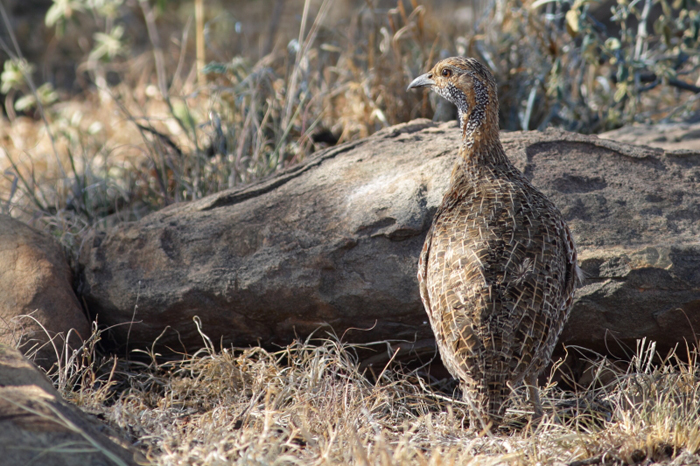
When we drove on, I saw something very interesting on the other side of an approaching drift, aside from a Fork-tailed Drongo, and just ordered Adam to prepare his bean bag and his camera and to not ask any questions. When I stopped in the drift, he knew it was worth doing what he was told and started making photos of a Rock Monitor. We learned something new: it had a forked tongue!
A very cooperative Rock Monitor
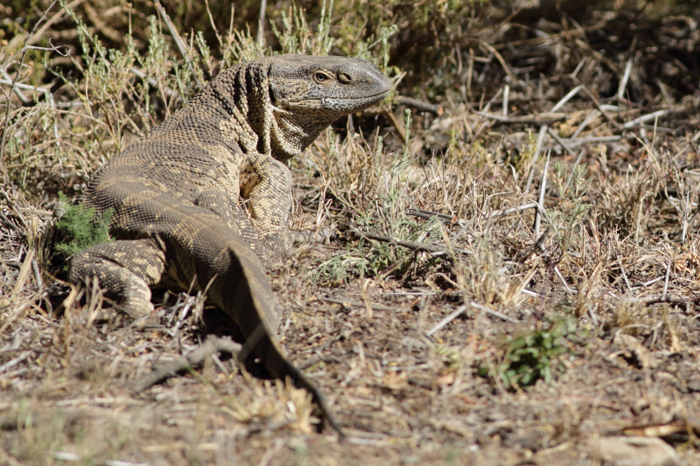

Out in the open grassland we heard our old friend the Cloud Cisticola, and as we entered Graham’s Corner we saw 14 Mountain Zebras, two Gemsboks and one Red Hartebeest. We stopped at the little dam with a convenient pull-off that was to be our turning point and saw quite a few Mountain Zebras drinking, two Yellow-throated Petronias in an acacia tree, a Common Fiscal, and a pair of Greater Striped Swallows. Two Helmeted Guineafowl seemed to spook the zebras temporarily, but there must have been at least 20 of them altogether. A Cape Wagtail flew low past the dam and a Three-banded Plover appeared shortly afterwards.
A couple of Mountain Zebras take some refreshment
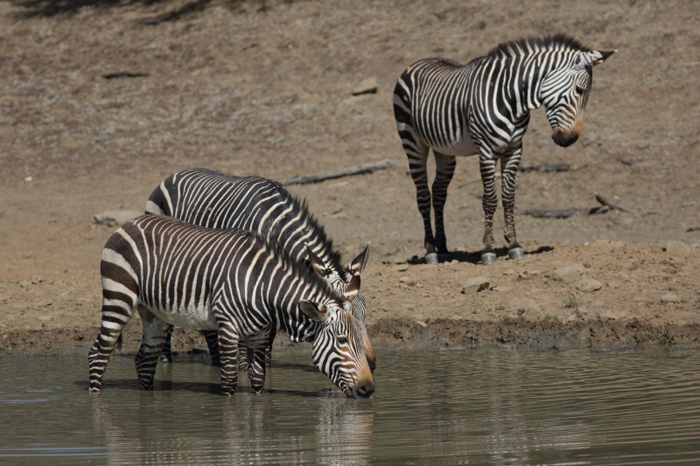
Another car pulled over behind us and after Adam was satisfied with his batch of photos we moved a bit further forward so that the people behind us could have a better look. They turned out to be our neighbours from the rest camp. We had a little chat and then returned to Graham’s Corner where we saw a Red Hartebeest shading itself under a tree and a few female Kudus browsing. Between the steep descents, an African Rock Pipit was heard again.
We didn’t start adding any new birds until we reached marker 3 and turned left to complete the Ubejane Loop. Among the acacias we heard a Cape Robin-Chat and saw a Chestnut-vented Tit-Babbler, a pair of Grey-headed Sparrows, an African Hoopoe and a Fiscal Flycatcher. When we got to a more open area, we encountered several Scaly-feathered Finches.
As we approached the large dam, we saw an Ant-eating Chat, two Pied Crows, a small but loud troop of Vervet Monkeys, and an African Pipit. No Pin-tailed Whydah for us this time, though. Instead, we saw a Southern Pale Chanting Goshawk soaring and then land at the other end of the dam and heard a Cape Turtle-Dove.
Driving on, we heard a Neddicky and saw several Cape Sparrows and five Red Hartebeest resting under acacia trees. We entered the Northern Ground Squirrel Area and saw that the killed Ground Squirrel from the night before had been claimed by a scavenger. We didn’t encounter any live ones, though, and only saw a few Ant-eating Chats and a Yellow Mongoose going into its burrow. Before we got to the main road at marker 1, we saw Barn Swallows, Pied Crows and a Familiar Chat.
Returning back to the rest camp on the main road, we saw six Springboks, an African Pipit, a Pied Starling and a Familiar Chat on a wire. Two Southern Pale Chanting Goshawks were soaring high to our right and as we passed through the rest-camp gate, Adam saw a Chinspot Batis.
We had coffee with the PB&J sandwich left over from the drive and wrote a text message to our host in Port Elizabeth about our arrival the next day and the weather forecast for our Sunday or Monday boat trip to Bird Island (part of Addo). He wrote back that Sunday’s conditions would be bad and Monday’s a bit better, but that we would have to wait a little longer to know more precisely, which made us consider extending our stay at Mountain Zebra for two more nights.
When we got to reception and enquired about this possibility, the rest camp had a vacancy on Sunday night, but it was fully booked on Saturday night. We asked about the availability at Addo and received the same answer. So we stuck to our plans and asked whether we could use the larger unit or at least the communal kitchen while we were at his place and learned that we could.
It was hot and we lazed the afternoon away, but then the clouds formed again and the wind picked up, making it more comfortable. We had a reservation for dinner on our last night in the park and thought we would go on foot and use Adam’s headlamp on the way back when it would be dark. Since the clouds looked threatening, we scrapped that plan and took the car and emptied our collection of glass and plastic recycling at the reception building.
We sat down at the same table in the corner of the restaurant where we were seated during our buffet lunch and there were two more tables occupied. Adam had his usual grilled chicken fillet with a side salad while I took the deep fried fish with a salad. We both decided to have a glass of Sauvignon Blanc and to treat ourselves to chocolate mousse with a scoop of ice-cream with chocolate sauce (Adam) and three scoops of vanilla ice-cream with chocolate sauce (me), one of which I generously gave to Adam when he had finished his dessert before I had.
When we got back home, we photographed part of the night sky and decided to do a two-hour morning drive before leaving for Port Elizabeth the next day.
The Hewitt’s Red Rock Rabbit was again around the chalet in the morning as was our crooner, the White-browed Sparrow-Weaver. Our departure from the chalet was delayed a bit by another Hewitt’s Red Rock Rabbit (!) with no white in the fur and no scars opposite Chalet 16. Adam got out of the car and photographed it.
Just another Hewitt's Red Rock Rabbit


We cleared the gate at 6:08 and turned right onto the main road, seeing two Mountain Zebras and a female Kudu eating straight away and two Yellow-throated Petronias. Our itinerary for this morning’s drive was to start the Ubejane Loop at marker 4, turn left onto the Link Road at marker 3, reach the little dam beyond Graham’s Corner, and then turn around and turn left at marker 3 to complete the Ubejane Loop.
As we crossed the Wilgerboom we heard Hadeda Ibises and later encountered two female Kudu browsing in the acacia tree which had been pushed over by the mother rhino the previous morning. Another female Kudu was spotted up the slope, a Neddicky was heard, and a couple of Ant-eating Chats were in the ‘Springhare’ field.
A Golden-breasted Bunting was singing on a wire in beautiful light and we saw seven Scaly-feathered Finches a bit further on. A Neddicky was spotted in a flowering acacia and a Chinspot Batis was singing nearby. Two female Kudu were browsing through the vegetation to our left as two Greater Striped Swallows flew over heads and a Common Fiscal sat on a wire. Barn Swallows were flying around us as we glimpsed an Acacia Pied Barbet and two White-browed Sparrow-Weavers sitting on neighbouring acacia trees.
We encountered some more Scaly-feathered Finches, heard an African Hoopoe, and saw a Brown-hooded Kingfisher perched on a wire. Five Pied Starlings and a Fork-tailed Drongo were seen with a singing Neddicky and Dideric Cuckoo providing the background sounds. A pair of Grey-headed Sparrows was in a tree and 10 Pied Starlings flew by. We heard another Hadeda Ibis calling and saw it as well. In a bush on the left side of the road, we saw a family of Familiar Chats with one young and another Acacia Pied Barbet.
Scaly-feathered Finch-love

On the right side of the road near the graves of 15 soldiers who had fought in the Anglo-Boer War and had died there, we saw a Sabota Lark, and a bit beyond it there was a Yellow Mongoose.
Between markers 5 and 4, we saw a Common Fiscal, a White-browed Sparrow-Weaver, a pair of Greater Striped Swallows perched and one of them preening, a Chestnut-vented Tit-Babbler, a Neddicky, and a wire-perched Familiar Chat. Then all of a sudden, a Green Wood-Hoopoe flew across the road and landed in a tree! Adam heard an African Rock Pipit from the rocks above on our right. Almost at marker 4, we could add a Fork-tailed Drongo, a pair of Fiscal Flycatchers, a calling Bokmakierie and two female Kudu to our field notes.
As we turned left onto the Ubejane Loop, a Karoo Scrub Robin and a family of at least four Familiar Chats welcomed us. A few Ground Lilies had sprung up after yesterday’s thundershowers. There were Springboks on our left and right (10 and 37, respectively) foraging, wagging their tails and springing into the air. A male Ostrich kept his cool amidst all the activity. Before the first drift we saw a Pied Starling on a power pole with one Common Fiscal and a Fork-tailed Drongo on a wire and a pair of Grey-headed Sparrows apparently nesting under a transformer high up on the pole.
Ground Lily

As we entered the Southern Ground Squirrel Area, we saw three pairs of Cape Sparrows, an Ant-eating Chat, a Ground Squirrel in the distance, and a Hadeda Ibis strutting through the field. There were also five Grey-headed Sparrows and several Scaly-feathered Finches, and we heard a Dideric Cuckoo again. Two Yellow Mongooses were having a wrestling match, jumping at and biting each other and rolling around on the ground. African Pipits, Ant-eating Chats and another Ground Squirrel were spotted and then we encountered a lone Red Hartebeest grazing on the left side of the road.
Barn Swallows were flying above us, more Scaly-feathered Finches were busy between the shrubs and trees, and a Cape Turtle-Dove was eating by the roadside. Three Rufous-eared Warblers and a pair of White-browed Sparrow-Weavers were encountered before we arrived at marker 3 where we turned left.
A sub-adult Southern Pale Chanting Goshawk was perched in a tree and a White-necked Raven was soaring above. Before the first steep ascent on the paved road began, we heard a Cape Turtle-Dove and a Neddicky and saw eight to ten Gemsboks near some shrubs. On the ascent itself we only encountered a Fiscal Flycatcher, had a bit of respite on the gravel, and then hit the second paved ascent and saw a Yellow-throated Petronia.
At the top we saw a few Mountain Zebras and then stopped to have a longer look at a pair of Grey Tits (one of which was singing) in a tree to our left which they shared with a Speckled Mousebird. A Gemsbok was a further away from us on our right, while five Mountain Zebras were even further away in a field above a cliff.
Adam saw a tiny bird disappear into a tree, so we stopped to try to find it and failed, but surprisingly for us we discovered a covey of Grey-winged Francolins in a rocky patch under the very same tree. As opposed to the Kranskop Loop covey that we heard but didn’t see, this one was silent and busy foraging for food.
Grey-winged Francolin

When we drove on, I saw something very interesting on the other side of an approaching drift, aside from a Fork-tailed Drongo, and just ordered Adam to prepare his bean bag and his camera and to not ask any questions. When I stopped in the drift, he knew it was worth doing what he was told and started making photos of a Rock Monitor. We learned something new: it had a forked tongue!
A very cooperative Rock Monitor


Out in the open grassland we heard our old friend the Cloud Cisticola, and as we entered Graham’s Corner we saw 14 Mountain Zebras, two Gemsboks and one Red Hartebeest. We stopped at the little dam with a convenient pull-off that was to be our turning point and saw quite a few Mountain Zebras drinking, two Yellow-throated Petronias in an acacia tree, a Common Fiscal, and a pair of Greater Striped Swallows. Two Helmeted Guineafowl seemed to spook the zebras temporarily, but there must have been at least 20 of them altogether. A Cape Wagtail flew low past the dam and a Three-banded Plover appeared shortly afterwards.
A couple of Mountain Zebras take some refreshment

Another car pulled over behind us and after Adam was satisfied with his batch of photos we moved a bit further forward so that the people behind us could have a better look. They turned out to be our neighbours from the rest camp. We had a little chat and then returned to Graham’s Corner where we saw a Red Hartebeest shading itself under a tree and a few female Kudus browsing. Between the steep descents, an African Rock Pipit was heard again.
We didn’t start adding any new birds until we reached marker 3 and turned left to complete the Ubejane Loop. Among the acacias we heard a Cape Robin-Chat and saw a Chestnut-vented Tit-Babbler, a pair of Grey-headed Sparrows, an African Hoopoe and a Fiscal Flycatcher. When we got to a more open area, we encountered several Scaly-feathered Finches.
As we approached the large dam, we saw an Ant-eating Chat, two Pied Crows, a small but loud troop of Vervet Monkeys, and an African Pipit. No Pin-tailed Whydah for us this time, though. Instead, we saw a Southern Pale Chanting Goshawk soaring and then land at the other end of the dam and heard a Cape Turtle-Dove.
Driving on, we heard a Neddicky and saw several Cape Sparrows and five Red Hartebeest resting under acacia trees. We entered the Northern Ground Squirrel Area and saw that the killed Ground Squirrel from the night before had been claimed by a scavenger. We didn’t encounter any live ones, though, and only saw a few Ant-eating Chats and a Yellow Mongoose going into its burrow. Before we got to the main road at marker 1, we saw Barn Swallows, Pied Crows and a Familiar Chat.
Returning back to the rest camp on the main road, we saw six Springboks, an African Pipit, a Pied Starling and a Familiar Chat on a wire. Two Southern Pale Chanting Goshawks were soaring high to our right and as we passed through the rest-camp gate, Adam saw a Chinspot Batis.
We had coffee with the PB&J sandwich left over from the drive and wrote a text message to our host in Port Elizabeth about our arrival the next day and the weather forecast for our Sunday or Monday boat trip to Bird Island (part of Addo). He wrote back that Sunday’s conditions would be bad and Monday’s a bit better, but that we would have to wait a little longer to know more precisely, which made us consider extending our stay at Mountain Zebra for two more nights.
When we got to reception and enquired about this possibility, the rest camp had a vacancy on Sunday night, but it was fully booked on Saturday night. We asked about the availability at Addo and received the same answer. So we stuck to our plans and asked whether we could use the larger unit or at least the communal kitchen while we were at his place and learned that we could.
It was hot and we lazed the afternoon away, but then the clouds formed again and the wind picked up, making it more comfortable. We had a reservation for dinner on our last night in the park and thought we would go on foot and use Adam’s headlamp on the way back when it would be dark. Since the clouds looked threatening, we scrapped that plan and took the car and emptied our collection of glass and plastic recycling at the reception building.
We sat down at the same table in the corner of the restaurant where we were seated during our buffet lunch and there were two more tables occupied. Adam had his usual grilled chicken fillet with a side salad while I took the deep fried fish with a salad. We both decided to have a glass of Sauvignon Blanc and to treat ourselves to chocolate mousse with a scoop of ice-cream with chocolate sauce (Adam) and three scoops of vanilla ice-cream with chocolate sauce (me), one of which I generously gave to Adam when he had finished his dessert before I had.
When we got back home, we photographed part of the night sky and decided to do a two-hour morning drive before leaving for Port Elizabeth the next day.
- Puff Addy
- Posts: 648
- Joined: Sun Jan 24, 2016 7:32 pm
- Country: Czech Republic
- Location: Prague, Czech Republic
- Contact:
Re: MZNP - A Nine-Night Stay in Cloud Cuckoo Land
@Rich: Thanks for the link to the thread.
@Mel: Scaly-feathered Finches are among my favorite birds, and there is no shortage of them at MZNP.
Rock Monitor is not uncommon at MZNP, and we had a monster at Camdeboo a couple of weeks earlier. We also saw the tail end of one near where we were staying in Somerset East a few days prior to that. We did not see any on our 2014 trip to the same region, so we were quite pleased.
It is hard to make Mountain Zebra photos that are not like the one you mention. That is 'the stare' they give from exactly that stance.
As for Aardwolf, I was really surprised that we didn't see one on our first night drive this trip, but then again we only did the Ubejane Loop that night. Our best sighting was actually on our night drive in 2014, when we got to see one digging a midden. Whatever you do, don't chase them. You are guaranteed to get blurry photos that way!
@Mel: Scaly-feathered Finches are among my favorite birds, and there is no shortage of them at MZNP.
Rock Monitor is not uncommon at MZNP, and we had a monster at Camdeboo a couple of weeks earlier. We also saw the tail end of one near where we were staying in Somerset East a few days prior to that. We did not see any on our 2014 trip to the same region, so we were quite pleased.
It is hard to make Mountain Zebra photos that are not like the one you mention. That is 'the stare' they give from exactly that stance.
As for Aardwolf, I was really surprised that we didn't see one on our first night drive this trip, but then again we only did the Ubejane Loop that night. Our best sighting was actually on our night drive in 2014, when we got to see one digging a midden. Whatever you do, don't chase them. You are guaranteed to get blurry photos that way!
- Puff Addy
- Posts: 648
- Joined: Sun Jan 24, 2016 7:32 pm
- Country: Czech Republic
- Location: Prague, Czech Republic
- Contact:
Re: MZNP - A Nine-Night Stay in Cloud Cuckoo Land
Day 10 – December 5, 2015
For the last time during our stay we woke up to a serenade performed by a White-browed Sparrow-Weaver. As we were preparing to go out, Adam heard an odd sound coming from the hillside and when he looked at the mountain to the left of the chalet, he knew what was making it – three Mountain Zebras were ‘hiking’. The sound was the clinking of their hooves against the rocks. There were two White-necked Ravens on the ground in the distance and our emaciated Eland was grazing with a Red-billed Oxpecker on its back. A Black Cuckoo was calling and so was a Red-chested Cuckoo, and a Neddicky was singing. While Adam was putting our stuff into the car, he saw a Red-faced Mousebird.
A Karoo Prinia was singing near the reception building and we cleared the rest-camp gate at 6:02 and turned left to spot a Familiar Chat on a wire. ‘Our’ herd of Red Hartebeest (the one that always came to graze in the evening) was still resting to the left of the road and together with us listened to the calls of fly-over Hadeda Ibises. At the exit from the park-administration drive, we heard a Willow Warbler singing and saw a lone Mountain Zebra and two Cape White-eyes.
A Chestnut-vented Tit-Babbler was singing at the turn-off for the first picnic area (14) and then we had a little bit of a traffic jam caused by 17 Helmeted Guineafowl that had hopped off the tree they had been roosting in onto the ground and casually proceeded to stroll down the road. As we entered a more rocky area, we saw a Common Fiscal, two Hadeda Ibises were flying past, a Red-eyed Dove was perched in a tree, and a pair of Bokmakieries were singing a duet in the vicinity of another Chestnut-vented Tit-Babbler.
At the Doornhoek Dam, we saw a Steppe Buzzard perched in a tree, a pair of Greater Striped Swallows, two White-breasted Cormorants flanking an African Darter in a dead tree in the water, a hunting Little Grebe, a Common Moorhen, two Red-knobbed Coots, and a pair each of African Black Ducks and Yellow-billed Ducks. A little further on, a Grey Heron was perched in a tallish tree.
As we passed the Doornhoek Guesthouse turn-off, we encountered Red-winged Starlings and Pied Starlings and then we spotted two Cape Buffaloes grazing on the left side of the road. What a huge animal it is! We spent ten minutes watching and photographing them, which also gleaned us a Pearl-breasted Swallow, a Fork-tailed Drongo, a Bar-throated Apalis, and a singing Karoo Prinia.
Driving on, three female Kudu were browsing in the thicket by the road as we heard a Red-chested Cuckoo and Black Cuckoo again – perhaps from the second picnic area where we had seen them in the huge eucalyptus tree. We thought we had seen our Cape Buffaloes for the day but we were wrong, as we came across a herd of at least 17 of them to our left.
Female Cape Buffalo

We had originally wanted to go all the way to the Wilgerboom ‘hairpin’, but it began to dawn on us that at the pace we had been travelling it would be impossible. So we just went as far as a turning point on a paved section of the road where we saw an adult male, a young male and two female Kudus and heard a Cape Robin-Chat.
As we started to make our way back, we spotted a male Steenbok to our left and were very happy about it as it was our first ‘diurnal’ one in the park. We passed our Cape Buffalo herd and ticked off a male Pin-tailed Whydah in a tree near marker 13. Just before marker 15 we saw a big male Kudu browsing, and when we got to the rest camp we saw a Long-billed Crombec with nesting material in its bill across from chalets 3 and 4.
Kudu browsing
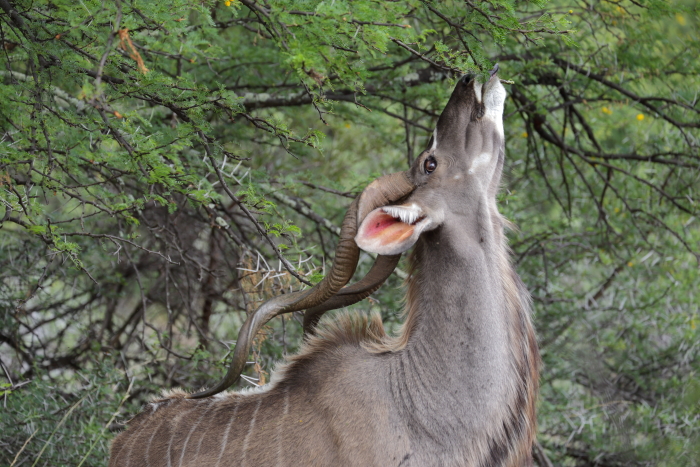
We got back shortly after eight and slowly started loading the car. When we left the chalet, we heard an African Rock Pipit and a Cape Robin-Chat and saw a Speckled Mousebird. We dropped off the key at reception at nine and before we had even made it out of the rest camp we first heard and then saw a Dideric Cuckoo in an acacia tree. The seeing-off committee also consisted of a Fiscal Flycatcher, a Familiar Chat, three Brown-hooded Kingfishers perched on a wire at different locations, a Southern Pale Chanting Goshawk on a pole, a Barn Swallow, an Ant-eating Chat, a Scaly-feathered Finch, and a troop of Chacma Baboons. One Red Hartebeest was shading itself under a tree, while 10 Black Wildebeest and two male Ostriches were grazing in the open.
Just over two kilometres from the park gate, Adam spotted a huge raptor perched on a utility pole so we stopped and were delighted to see a Martial Eagle. Closer to the gate we saw 16 Barn Swallows. Our friendly guard Mhlabantu was at the gate and saw us off. On the very washboard-like road to the junction with the R61, we saw four kestrels soaring together, a Yellow Mongoose, an Acacia Pied Barbet, and more Barn Swallows.
Until next time, Mountain Zebra!
For the last time during our stay we woke up to a serenade performed by a White-browed Sparrow-Weaver. As we were preparing to go out, Adam heard an odd sound coming from the hillside and when he looked at the mountain to the left of the chalet, he knew what was making it – three Mountain Zebras were ‘hiking’. The sound was the clinking of their hooves against the rocks. There were two White-necked Ravens on the ground in the distance and our emaciated Eland was grazing with a Red-billed Oxpecker on its back. A Black Cuckoo was calling and so was a Red-chested Cuckoo, and a Neddicky was singing. While Adam was putting our stuff into the car, he saw a Red-faced Mousebird.
A Karoo Prinia was singing near the reception building and we cleared the rest-camp gate at 6:02 and turned left to spot a Familiar Chat on a wire. ‘Our’ herd of Red Hartebeest (the one that always came to graze in the evening) was still resting to the left of the road and together with us listened to the calls of fly-over Hadeda Ibises. At the exit from the park-administration drive, we heard a Willow Warbler singing and saw a lone Mountain Zebra and two Cape White-eyes.
A Chestnut-vented Tit-Babbler was singing at the turn-off for the first picnic area (14) and then we had a little bit of a traffic jam caused by 17 Helmeted Guineafowl that had hopped off the tree they had been roosting in onto the ground and casually proceeded to stroll down the road. As we entered a more rocky area, we saw a Common Fiscal, two Hadeda Ibises were flying past, a Red-eyed Dove was perched in a tree, and a pair of Bokmakieries were singing a duet in the vicinity of another Chestnut-vented Tit-Babbler.
At the Doornhoek Dam, we saw a Steppe Buzzard perched in a tree, a pair of Greater Striped Swallows, two White-breasted Cormorants flanking an African Darter in a dead tree in the water, a hunting Little Grebe, a Common Moorhen, two Red-knobbed Coots, and a pair each of African Black Ducks and Yellow-billed Ducks. A little further on, a Grey Heron was perched in a tallish tree.
As we passed the Doornhoek Guesthouse turn-off, we encountered Red-winged Starlings and Pied Starlings and then we spotted two Cape Buffaloes grazing on the left side of the road. What a huge animal it is! We spent ten minutes watching and photographing them, which also gleaned us a Pearl-breasted Swallow, a Fork-tailed Drongo, a Bar-throated Apalis, and a singing Karoo Prinia.
Driving on, three female Kudu were browsing in the thicket by the road as we heard a Red-chested Cuckoo and Black Cuckoo again – perhaps from the second picnic area where we had seen them in the huge eucalyptus tree. We thought we had seen our Cape Buffaloes for the day but we were wrong, as we came across a herd of at least 17 of them to our left.
Female Cape Buffalo

We had originally wanted to go all the way to the Wilgerboom ‘hairpin’, but it began to dawn on us that at the pace we had been travelling it would be impossible. So we just went as far as a turning point on a paved section of the road where we saw an adult male, a young male and two female Kudus and heard a Cape Robin-Chat.
As we started to make our way back, we spotted a male Steenbok to our left and were very happy about it as it was our first ‘diurnal’ one in the park. We passed our Cape Buffalo herd and ticked off a male Pin-tailed Whydah in a tree near marker 13. Just before marker 15 we saw a big male Kudu browsing, and when we got to the rest camp we saw a Long-billed Crombec with nesting material in its bill across from chalets 3 and 4.
Kudu browsing

We got back shortly after eight and slowly started loading the car. When we left the chalet, we heard an African Rock Pipit and a Cape Robin-Chat and saw a Speckled Mousebird. We dropped off the key at reception at nine and before we had even made it out of the rest camp we first heard and then saw a Dideric Cuckoo in an acacia tree. The seeing-off committee also consisted of a Fiscal Flycatcher, a Familiar Chat, three Brown-hooded Kingfishers perched on a wire at different locations, a Southern Pale Chanting Goshawk on a pole, a Barn Swallow, an Ant-eating Chat, a Scaly-feathered Finch, and a troop of Chacma Baboons. One Red Hartebeest was shading itself under a tree, while 10 Black Wildebeest and two male Ostriches were grazing in the open.
Just over two kilometres from the park gate, Adam spotted a huge raptor perched on a utility pole so we stopped and were delighted to see a Martial Eagle. Closer to the gate we saw 16 Barn Swallows. Our friendly guard Mhlabantu was at the gate and saw us off. On the very washboard-like road to the junction with the R61, we saw four kestrels soaring together, a Yellow Mongoose, an Acacia Pied Barbet, and more Barn Swallows.
Until next time, Mountain Zebra!


